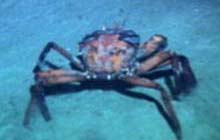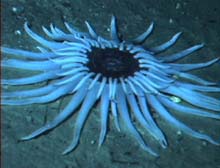Summary of the Expedition
The Deep East expedition spanned 1,000 mi, from Georges Bank to the Blake Ridge off the U.S. Eastern Seaboard. Of the planned 15 dives, 11 descended to depths reaching 3,000 meters -- more than a mile and a half below the ocean surface. Only one U.S. manned submersible, the R/V Alvin, can dive so deep. It often takes years to analyze and publish all of the research results from such an expedition. Following are some of the expedition's preliminary findings.
Leg One: Georges Bank
Even though only two dives were completed during the first leg of the expedition, (three were cancelled due to rough seas generated by Hurricane Erin), the following new discoveries were made:
• An unusual foraging behavior was observed in deep-sea fish. Rather than the expected active foraging behavior, most of the 17 fish species observed in Oceanographer Canyon exhibited a sit-and-wait foraging strategy. This was surprising, because the apparent low availability of food suggested that fish would have to actively seek out their meals.
• A novel swimming behavior of a deep-sea shrimp was observed.

A relationship was observed in the red crab's (Chayceon quinquedens) distribution at depth by size. Click image for larger view.
• An relationship was observed between the size distribution of the red crab (Chaceon quinquedons) and depth. Numerous red crabs were seen in both Oceanographer and Hydrographer Canyons. The crabs were seen to use burrows in the soft bottom, and it appears that they may be distributed by depth according to their size (i.e., age).
• Tissue samples were collected from the deep-sea corals Paramuricea grandis, Anthothela sp., and Thourella sp. These samples will be used to obtain the first ever DNA sequences of these species. Their genetic data will be added to a database of deep-sea coral sequences, which can be used in the future for species identification and in preparation for studies of dispersal between geographic sampling areas (e.g., between canyons and seamounts). At this state, it is unclear whether any of the species collected or photographed are new to science; this will require further laboratory analysis of the specimens.
• Eggs and sperm packets were collected from two specimens brought aboard the Atlantis (one anemone and one coral). A lab analysis of these samples will provide the first picture of invertebrate reproduction in deep-sea habitats.
• An anemone (Amphianthus mirabilis) was observed at a depth of 840 m. This is deeper than any previously recorded observation for the species.
Leg Two: Hudson Canyon
During Leg Wwo, Deep East explorers had four primary expedition objectives:
• Explore deep-sea diversity in the Hudson Submarine Canyon;
• Determine the fate and effects of past dumping activities at the DWD 106-mile Site;
• Explore the processes governing the distribution and stability of gas-hydrate deposits; and
• Explore the potential occurrence of exotic communities associated with active methane venting from hydrate beds.

Two eel-pout fish swim by Alvin's porthole. Notice the fine-grained sediment covering the sea floor at the DWD 106-mile Dumpsite. Click image for larger view.
The original mission plan to begin diving in the Hudson Canyon on September 15 was altered by the closure of New York’s harbor due to the events of September 11. On September 16, Leg Two got under way after departing from Wood’s Hole, MA. Five dives were conducted in and around the Hudson Submarine Canyon. In addition to Alvin dives, nighttime box core and CTD rosette sampling focused on the collection of deep-sea sediments, water samples, and data concerning salinity and temperature at increasing depths.
Scientists collected orange sea and brittle stars, white sea urchins, and a violet, foot-long sea cucumber. The DWD-106 region’s bathymetry contained multiple ridges and valleys covered by snow-like layers of fine sediment. Observations indicated that the Hudson Canyon is a dynamic site that may hold great promise for the identification of new species with potential in the field of biotechnology.
The preliminary results of geological studies showed an elevated methane signal throughout the Hudson Canyon region, indicating that active methane vents occur in the area. Three dives, centered on the upper canyon axis and flank, revealed a habitat rich in fauna. During one dive, the Alvin descended into a swarm of lanternfish being preyed upon by schools of squid. The squid were lining up in formations and attacking the lantern fish in small groups. On another dive, Alvin descended into a blizzard of shrimp and krill. An number of bright silver, needle-like fish (species unknown) were observed positioning themselves vertically in the water column to feast on the tiny prey.
The Leg Two scientists were very pleased with the productivity of their short cruise, and believe that further analysis of sediment and water samples will lead to a better understanding of the processes governing both stability and changes in the deep-sea realm.

This deep-sea anemone exemplifies the beatiful and diverse biota at the Blake Ridge site. Click image for larger view.
Leg Three: Blake Ridge
For two decades, the exploration of vent and seep communities around the world has revealed a new world of life that depends on carbon and energy emanating from beneath the sea floor. Most of the study areas, such as the hydrothermal vents and oil and gas seeps in the Gulf of Mexico, have high rates of flow. Previous Ocean Drilling Program (ODP) studies on Blake Ridge revealed a massive bed of gas hydrate containing approximately 55 trillion cubic ft of methane derived from the bacterial composition of organic deposits on the ridge.
Based on this knowledge, scientists expected the rate of seepage here to be much slower, and perhaps the chemosynthetic organisms feeding on them to be smaller and less abundant, than in other vent and seep communities. Instead, they found some of the largest seep organisms ever discovered, and in densities and diversities comparable to, or greater than, any known seep and vent sites. As one example, a large mussel bed the size of a football field contained mussels the size of footballs! Pending further analysis of the collected samples, several new species of animals associated with the bed are expected, including shrimps, worms, and clams. Some may harbor new symbiotic relationships that could change our fundamental understanding of the global web of life.
Exploring an old ODP drill hole opened up new and exciting opportunities on Blake Ridge. Most gas hydrates in the ocean are buried under sediments. Disturbances around an old ODP drill hole opened up a crevasse that the Alvin submersible was able to explore. The walls of the crevasse were layered with hydrates, and seeping gas was evident. The scientists were the first people, as far as any of them know, to actually observe the formation of a gas hydrate outcrop in a natural setting. This was an unprecedented opportunity to address the new multi-agency Methane Hydrate Program's need to better understand the nature of hydrates, hydrate-laden sediments, and the interaction between the global methane-hydrate reservoir and the world's oceans and atmosphere.
Sign up for the Ocean Explorer E-mail Update List.
































